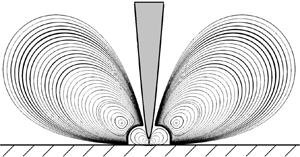Article contents
Moffatt eddies in electrohydrodynamics flows: numerical simulations and analyses
Published online by Cambridge University Press: 06 December 2022
Abstract

We study numerically a sequence of eddies in two-dimensional electrohydrodynamics (EHD) flows of a dielectric liquid, driven by an electric potential difference between a hyperbolic blade electrode and a flat plate electrode (or the blade–plate configuration). The electrically driven flow impinges on the plate to generate vortices, which resemble Moffatt eddies (Moffatt, J. Fluid Mech., vol. 18, 1964, pp. 1–18). Such a phenomenon in EHD was first reported in the experimental work of Perri et al. (J. Fluid Mech., vol. 900, 2020, A12). We conduct direct numerical simulations of the EHD flow with three Moffatt-type eddies in a large computational domain at moderate electric Rayleigh numbers ( $T$, quantifying the strength of the electric field). The ratios of size and intensity of the adjacent eddies are examined, and they can be compared favourably to the theoretical prediction of Moffatt; interestingly, the quantitative comparison is remarkably accurate for the two eddies in the far field. Our investigation also shows that a larger
$T$, quantifying the strength of the electric field). The ratios of size and intensity of the adjacent eddies are examined, and they can be compared favourably to the theoretical prediction of Moffatt; interestingly, the quantitative comparison is remarkably accurate for the two eddies in the far field. Our investigation also shows that a larger  $T$ strengthens the vortex intensity, and a stronger charge diffusion effect enlarges the vortex size. A sufficiently large
$T$ strengthens the vortex intensity, and a stronger charge diffusion effect enlarges the vortex size. A sufficiently large  $T$ can further result in an oscillating flow, consistent with the experimental observation. In addition, a global stability analysis of the steady blade–plate EHD flow is conducted. The global mode is characterised in detail at different values of
$T$ can further result in an oscillating flow, consistent with the experimental observation. In addition, a global stability analysis of the steady blade–plate EHD flow is conducted. The global mode is characterised in detail at different values of  $T$. When
$T$. When  $T$ is large, the confinement effect of the geometry in the centre region may lead to an increased oscillation frequency. This work contributes to the quantitative characterisation of the Moffatt-type eddies in EHD flows.
$T$ is large, the confinement effect of the geometry in the centre region may lead to an increased oscillation frequency. This work contributes to the quantitative characterisation of the Moffatt-type eddies in EHD flows.
JFM classification
- Type
- JFM Papers
- Information
- Copyright
- © The Author(s), 2022. Published by Cambridge University Press
References
REFERENCES
- 1
- Cited by



